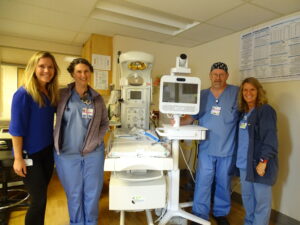
Members of Copley Hospital’s birthing center team, with Administrative Leader Grace Thompson (left).
Copley Hospital in Morrisville and North Country Hospital in Newport now have telemedicine equipment that allows both audio and visual communication between each of these two rural critical access hospitals and the University of Vermont Medical Center in Burlington during the transport process for newborns with life-threatening conditions.
Newborns in need of critical care in Vermont are often transported to the neonatal intensive care unit (NICU) at The University of Vermont Children’s Hospital – the only NICU in Vermont – when they are born prematurely, are in need of supportive measures like respiratory therapy or require life-saving care and surgery. But the precarious time between childbirth and before babies arrive at the NICU can present its own challenges, especially when the babies can be a two-hour drive away, over winding mountain roads.
How it works:
Cameras with high video resolution have been installed at Copley Hospital and North Country Hospital, allowing specialists at the UVM Children’s Hospital NICU to see what’s happening with the baby, providing real-time advice to care teams on the ground preparing infants for transport.
“I feel like I’m present in the room,” said Charles Mercier, MD, MPH, at UVM Children’s Hospital. “I can zoom in and see features of the baby that puts me right at the bedside. It’s a remarkable technology. In this way, we all collaborate to provide the best support and care we can with the resources we have.”
A collaborative care plan and coaching among respiratory therapists, nurses and physicians can be established in real-time during the entire transport process. Transport ambulances have also been equipped with cameras connecting them with the NICU, meaning that connected care on the way back to the NICU can be continuous. Before the high-tech video systems were available, doctors and care teams were limited to telephones for communication.
Grace Thompson, administrative leader for Women’s and Newborn Services at Copley Hospital, said that while they have not yet used the equipment, the clinical team has been trained on its use and are glad to have it as a resource. “Previously, we would call to initiate a transport and verbally discuss options,” she said. “Now, providers at the UVM Medical Center can get a better picture of what is happening with the baby. The camera has the ability to zoom in on monitors to see the situation firsthand.”
“While everyone plans for a healthy newborn, not everyone plans on the possibility of complications requiring special care,” said Steven Soriano, DO, Chief of Pediatrics at Copley Hospital. “We are fortunate to have received this life-saving equipment. Having access to this level of technology ensures a more positive outcome for the newborn.”
“This opportunity will increase the quality of our neonatal care even further and greatly benefit our youngest patients,” said North Country Hospital Pediatrics Medical Director Dr. Alexandra Bannach.
Hospitals working together
Tom Frank, President and CEO of North Country Hospital, emphasized the importance of hospitals working together, and highlighted the close working relationship that North Country and the UVM Medical Center have formed over the years. “It’s great having a partnership such as this, in order to take care of our youngest patients in the northernmost part of the state,” he said. “We appreciate UVM Medical Center providing the telemedicine cart to North Country free of charge.”
The collaboration has so far involved all UVM Health Network hospitals, and has expanded to North Country and Copley thanks to funding from the UVM Medical Center Foundation. The UVM Medical Center Fund is supported through philanthropic contributions from the community, which are then invested directly into UVM Medical Center’s mission-driven initiatives. As a nonprofit organization, the UVM Medical Center, including the UVM Children’s Hospital and the UVM Cancer Center, relies on private philanthropic support to achieve its mission.
“This is a wonderful example of how our system of entirely nonprofit hospitals work together across regions, and even mountain ranges, to deliver the highest quality care possible,” said Mike Del Trecco, President and CEO of the Vermont Association of Hospitals and Health Systems. “On any given day, our hospitals are collaborating, because our shared mission is to ensure that all resources go to providing patient care as close to home as safely possible. When a patient, such as an infant born prematurely, needs stabilization and specialized care before and during transport, the cross-hospital team work can be lifesaving.”
“We do not take care of babies who are born very, very early, very often. And so if a baby is born suddenly under emergency conditions here at Central Vermont Medical Center and only weighs a couple of pounds, I want help as quickly as I can get it,” said Anna Hankins, MD, a pediatrician at CVMC, who has had opportunities to use the equipment. “These are tiny, very vulnerable infants. I always breathe that big sigh of relief when the transport team arrives from UVM Children’s Hospital.”
